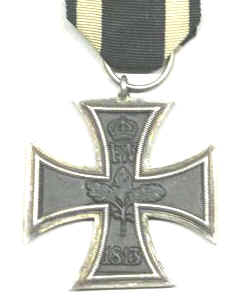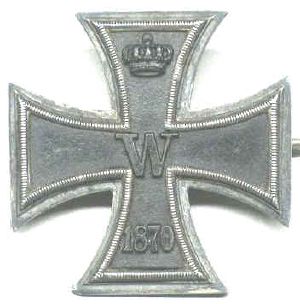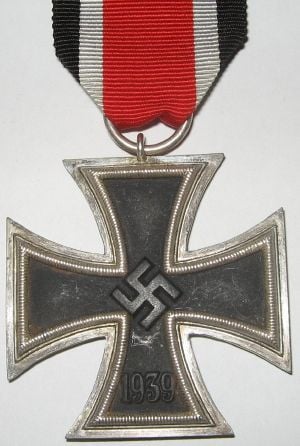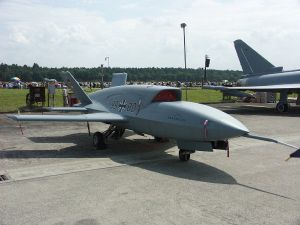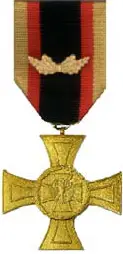Iron Cross
The Iron Cross was a military decoration of the Kingdom of Prussia, and later of Germany, which was established by King Frederick William III of Prussia and first awarded on March 10, 1813 in Breslau (now WrocĆaw). In addition to the Napoleonic Wars, the Iron Cross was awarded during the Franco-Prussian War, World War I, and World War II.
In 1939 Adolf Hitler added a "marching swastika" in the center of the cross and reinstituted it in its original three classes, with the addition of the Knightâs Cross. The Iron Cross is only awarded in wartime and has not been awarded since May 1945.
On October 1, 1956 the Federal President, Theodor Heuss, gave directions to use the Iron Cross as the official emblem of the Bundeswehr when the German Army was reconstituted. German law now prohibits the wearing of a swastika, so in 1957 the West German government authorized replacement Iron Crosses with an Oak Leaf Cluster in place of the swastika, similar to the Iron Crosses of 1813, 1870, and 1914, which could be worn by World War II Iron Cross recipients.
After German reunification, it appears in the colors blue and silver as the symbol of the "new" Bundeswehr. The new design does not replace the traditional black military Iron Cross, which can be found on all armored vehicles, tanks, naval vessels, and planes of modern German forces.
Design
The Iron Cross (a black four-pointed cross with white trim, with the arms widening towards the ends, similar to a cross pattée), was designed by the neoclassical architect Karl Friedrich Schinkel and reflects the cross worn by the Teutonic Knights in the fourteenth century.
Friedrick Wilhelm required that the concept include the Prussian Crown, his royal cipher, the date of institution (1813), and a representation of oak leaves, the sacred tree of Germany.
As the ancient tree associated with the original Germanic tribes, the oak is a great source of national pride, and was designated as the symbol of German patriotism by the eighteenth-century playwright Friedrich Gottlieb Klopstock.[1]
Three classes of the award were created; Second, First and Grand Cross and all the awards were to be awarded without distinction to rank.
The ribbon for the 1813, 1870 and 1914 Iron Cross (2nd Class) was black with two thin white bands, the colors of Prussia. The noncombatant version of this award had the same medal, but the black and white colors on the ribbon were reversed.
Since the Iron Cross was issued over several different periods of German history, it was annotated with the year indicating the era in which it was issued. For example, an Iron Cross from World War I bears the year "1914," while the same decoration from the World War II is annotated "1939." The reverse of the 1870, 1914 and 1939 series of Iron Crosses have the year "1813" appearing on the lower arm, symbolizing the first year the award was created.
It was also possible for a holder of the 1914 Iron Cross to be awarded a higher grade of the 1939 Iron Cross. An award of the first or second class was also possible. In such cases a "1939 Clasp" (Spange) would be worn on the original 1914 Iron Cross. (A similar award was made in 1914, but was quite rare since there were few in service who held the 1870 Iron Cross.)
Early awards
The Iron Cross was first awarded to soldiers during the Wars of Liberation against Napoleon. King Wilhelm I of Prussia authorized further awards in 1870, during the Franco-German War. Recipients of the 1870 Iron Cross who were still in service in 1895 were authorized to purchase a 25-year clasp consisting of the numerals "25" on three oak leaves. The Iron Cross was reauthorized by Emperor Wilhelm II in 1914, at the start of World War I. During these three periods, the Iron Cross was an award of the Kingdom of Prussia, although given Prussia's pre-eminent place in the German Empire formed in 1881, it tended to be treated as a generic German decoration. The 1813, 1870, and 1914 Iron Crosses had three grades:
- Iron Cross 2nd Class (German: Eisernes Kreuz 2. Klasse)
- Iron Cross 1st Class (German: Eisernes Kreuz 1. Klasse)
- Grand Cross of the Iron Cross (German: GroĂkreuz des Eisernen Kreuzes, often simply GroĂkreuz)[2]
Although the medals of each class were identical, the manner in which each was worn differed. Employing a pin or screw posts on the back of the medal, the Iron Cross First Class was worn on the left side of the recipient's uniform. The Grand Cross and the Iron Cross Second Class were suspended from different ribbons.
The Grand Cross was intended for senior generals of the German Army. An even higher decoration, the Star of the Grand Cross of the Iron Cross, was awarded only twice, to Field Marshal Gebhard von BlĂŒcher in 1813 and to Field Marshal Paul von Hindenburg in 1918. A third award was planned for the most successful German general during World War II, but was not made after the defeat of Germany in 1945.
The Iron Cross 1st Class and the Iron Cross 2nd Class were awarded without regard to rank. One had to already possess the 2nd Class in order to receive the 1st Class (though in some cases both could be awarded simultaneously). The egalitarian nature of this award contrasted with those of most other German states (and indeed many other European monarchies), where military decorations were awarded based on the rank of the recipient. For example, Bavarian officers received various grades of that Kingdom's Military Merit Order (MilitÀr-Verdienstorden), while enlisted men received various grades of the Military Merit Cross (MilitÀr-Verdienstkreuz). Prussia did have other orders and medals which were awarded on the basis of rank, and even though the Iron Cross was intended to be awarded without regard to rank, officers and NCOs were more likely to receive it than junior enlisted soldiers.[2]
World War I
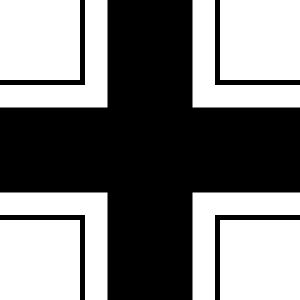
During the reign of Wilhelm II and the outbreak of World War I, the symbol of his grandfather and great grandfather was reinstituted. World War I was also the symbolâs first defeat. While substituting the 1870 of the Franco-Prussian period with the new date of 1914 very little change in the general appearance of all three classes took place.
Approximately 4 million Second Classes and 145,000 First Classes were awarded in World War I. Only the Grand Cross was awarded less, with five total. Field Marshal Paul von Hindenburg received the Star to the Grand Cross, its only recipient of World War I, and second only to BlĂŒcherâs 1815 bestowal.[3]
Exact numbers of awards are not known, since the Prussian archives were destroyed during World War II. The multitude of awards reduced the status and reputation of the decoration. Among the holders of the 1914 Iron Cross 1st Class was Adolf Hitler, which was unusual as very few holders of the 1914 Iron Cross 1st Class were enlisted soldiers; Hitler held the rank of Gefreiter (Corporal). Hitler can be seen wearing the award on his left breast, as was standard, in many photographs.[2]
Today these are the most common variety of Iron Cross available. Many were brought back from the war by American soldiers.
World War II
Adolf Hitler restored the Iron Cross in 1939 as a German decoration (rather than Prussian as in earlier versions), continuing the tradition of issuing it in various grades. The Iron Cross of World War II was divided into three main series of decorations with an intermediate category, the Knight's Cross, instituted between the lowest, the Iron Cross, and the highest, the Grand Cross. The Knight's Cross replaced the Prussian Pour le MĂ©rite or "Blue Max."
Hitler did not care for the Pour le MĂ©rite, as it was a Prussian order that could be awarded only to officers. The ribbon of the medal (2nd class and Knight's Cross) was different from the earlier Iron Crosses in that the color red was used in addition to the traditional black and white (black and white were the colors of Prussia, while black, white, and red were the colors of Germany). Hitler also created the War Merit Cross as a replacement for the non-combatant version of the Iron Cross.
Iron Cross
The standard 1939 Iron Cross was issued in the following two grades:
- Iron Cross 2nd Class (Eisernes Kreuz 2. Klasse)
- Iron Cross 1st Class (Eisernes Kreuz 1. Klasse) (abbreviated as EKI or E.K.I.)[4]
The Iron Cross was awarded for bravery in battle as well as other military contributions in a battlefield environment.
The Iron Cross 2nd Class came with a ribbon and was worn in one of three different methods:
- From the second button of the tunic.
- When in formal dress, the entire cross was worn mounted alone or as part of a medal bar.
- For everyday wear, only the ribbon was worn from the second hole in the tunic button.
The Iron Cross First Class was a pin-on medal with no ribbon and was worn centered on a uniform breast pocket, either on dress uniforms or everyday outfit. It was a progressive award, with second class having to be earned before the first class and so on for the higher degrees.
It is estimated that some four and a half million Second Class Iron Crosses were awarded in the Second World War, and 300,000 of the First Class (Previtera 1999, 322).
Two Iron Cross First Class recipients were women, one of whom was test pilot Hanna Reitsch. The only Muslim to have ever received the award, SS ObersturmfĂŒhrer Imam Halim MalkoÄ, was granted the Iron Cross (Second Class) in October 1943 for his role in suppressing the Villefranche-de-Rouergue mutiny. Two Jewish officers of the Finnish army and one female Lotta SvĂ€rd member were awarded Iron Crosses, but they would not accept them.[5]
Knight's Cross of the Iron Cross
The Knight's Cross of the Iron Cross (Ritterkreuz des Eisernen Kreuzes, often simply Ritterkreuz) recognized extreme battlefield bravery or successful leadership. The Knight's Cross was divided into five degrees:
- Knight's Cross (Ritterkreuz des Eisernen Kreuzes)
- Knight's Cross with Oak Leaves (mit Eichenlaub)
- Knight's Cross with Oak Leaves and Swords (mit Eichenlaub und Schwertern)
- Knight's Cross with Oak Leaves, Swords, and Diamonds (mit Eichenlaub, Schwertern und Brillanten)
- Knight's Cross with Golden Oak Leaves, Swords, and Diamonds (mit Goldenem Eichenlaub, Schwertern und Brillanten)
In total, 7,313 awards of the Knight's Cross were made. Only 883 received the Oak Leaves; 160 both the Oak Leaves and Swords (including Japanese Admiral Isoroku Yamamoto (posthumously); 27 with Oak Leaves, Swords and Diamonds.
The only holder of the Golden Oak Leaves, Swords, and Diamonds was Hans Ulrich Rudel of the Luftwaffe. A Stuka dive bomber pilot, Rudel destroyed 518 Russian tanks, 150 flak and artillery positions, 700 trucks, sunk the Russian battleship Marat, a Russian cruiser, a Russian Destroyer, 70 Russian landing craft, and hundreds of other targets (bridges, railways, bunkers). He also heavily damaged another Russian battleship, the October Revolution. Rudel flew 2,530 combat missions, of which 400 were in a Focke-Wulf 190, claimed 11 air victories and was shot down 32 times.[6]
Side features of the Iron Cross and entitlements
Officers awarded the Iron Cross were given entitlements and often wore signifying articles, such as an Iron Cross signet ring or cloth Iron Cross which could be affixed to clothing. Also, during the Nazi period, those attaining more than one award, were entitled to wear a single pin to consolidate awards. For example, an officer who had attained an Iron Cross 1st class, an Iron Cross 2nd class and the Knight's Cross of the Order of the Iron Cross with the Oak Leaves, were entitled to wear a pin which exhibited three Iron Crosses with an exaggerated swastika.
Grand Cross of the Iron Cross (1939)
Like the Knight's Cross, the Grand Cross (GroĂkreuz) was also worn suspended from the collar. The only recipient of the Grand Cross during World War II was Reichsmarschall Hermann Göring, who was awarded the decoration on July 19, 1940. The medal is in effect an over-sized Knight's Cross. It had the same overall characteristics as the Knights Cross but was much larger, measuring 63 mm in width as opposed to about 44 mm for the Iron Cross and 48.5 mm for the Knight's Cross. It was originally intended to have outer edges lined in gold, but this was changed to silver before the award was presented.
The Grand Cross was worn with a 57 mm-wide ribbon bearing the same colors as the Knights Cross and 2nd-Class ribbons. The award case was in red leather with the eagle and the swastika outlined in gold.
The Grand Cross was not a bravery award. It was reserved solely for General Staff officers for "the most outstanding strategic decisions affecting the course of the war." Göring received the Grand Cross for his command of the Luftwaffe during the successful 1940 campaigns against France, Belgium, and the Netherlands (at the same time as he was promoted to Reichsmarschall of the Greater German Reich).
The original Grand Cross that was presented to Göring (personally by Hitler) was destroyed during an air raid on his Berlin home. Göring had extra copies made, one of them with a platinum frame that he was wearing at the time of his surrender to the allies in 1945.
Several times in official photographs, Göring can be seen wearing his Pour le Mérite, Knights Cross, and Grand Cross around his neck at the same time.
Star of the Grand Cross of the Iron Cross (1939)
The Star of the Grand Cross of the Iron Cross (also called Iron Cross with Golden Rays) was meant to be worn like the Iron Cross First class (pinned to the breast.) Like the Grand Cross of the Iron Cross, this award was not intended to be bestowed for bravery. Rather, it was bestowed upon the most successful General officer at the conclusion of a war.
The first Star of the Grand Cross was presented to Gebhard Leberecht von BlĂŒcher for defeating Napoleon in the Battle of Waterloo, 1815. That medal is called the BlĂŒcherstern (BlĂŒcher's Star). The second version of the Star of the Grand Cross of the Iron Cross was presented to Paul von Hindenburg for the German victories over the British in the German offensives in March and April 1918. A Star of the Grand Cross of the Iron Cross was manufactured for World War II, but it was never awarded. The only known example was found by Allied occupation forces at the end of the war, and was eventually added to the West Point military collection. It is generally believed that Reichsmarschall Hermann Göring was the intended eventual recipient. The design was based on the 1914 version of the Star of the Grand Cross, but with the 1939 Iron Cross as the centerpiece.
Cross of Honor of the German Mother
The Cross of Honor of the German Mother (German: Ehrenkreuz der deutschen Mutter or more colloquially Mutterkreuz), was instituted on December 16, 1938 as part of Hitler's initiative to encourage Aryan population growth, and so only women with pure Aryan families could achieve such awards. Women from absorbed Germanic countries (such as Austria and Danzig) were also eligible. A mother could be awarded a bronze, silver, or gold cross depending on the number of children she had born. Eight would entitle the woman to a gold cross, six for silver, and four for bronze.
The crosses were awarded annually on August 12 (Hitler's mother's birthday), and the second Sunday in May (Mothering Sunday), hence the first of these were not awarded until 1939.[7]
Post-World War II
German law prohibits the wearing of a swastika, so in 1957 the West German government authorized replacement Iron Crosses with an Oak Leaf Cluster in place of the swastika, similar to the Iron Crosses of 1813, 1870, and 1914, which could be worn by World War II Iron Cross recipients. The 1957 law also authorized de-Nazified versions of most other World War II-era decorations (except those specifically associated with Nazi Party organizations, such as SS Long Service medals, or with the expansion of the German Reich, such as the medals for the annexation of Austria, the Sudetenland, and the Memel region).
Since German armed forces began seeing active service again, first in Kosovo and then in Afghanistan, there has been a campaign to revive the Iron Cross and other military medals, since Germany currently has no awards specifically for active military service. In 2007, a petition to the German parliament to revive the Iron Cross decoration received over 5,000 signatures.
In October 2008, the German defense minister created a new grade of the Ehrenzeichen der Bundeswehr, the Ehrenkreuz der Bundeswehr fĂŒr Tapferkeit (Bundeswehr Cross of Honour for Bravery).
The Iron Cross was used as the symbol of the German Army until 1915, when it was replaced by a simpler Greek cross. However, in 1956 the President of Germany, Theodor Heuss, gave directions to use the Iron Cross as the official emblem of West Germany's Bundeswehr. Today, after German reunification, it appears in the colors blue and silver as the symbol of the "new" Bundeswehr. This design does not replace the traditional black Iron Cross, however, which can be found on all armored vehicles, planes and helicopters of today's German forces.
Legacy
According to the Frankfurter Allgemeine Zeitung, conservative parliamentarian Ernst-Reinhard Beck had recommended modeling the new medal on the Iron Cross. Beck, a member of Angela Merkel's Christian Democratic Union, is also head of Germany's army reservists association.
"We should reclaim the positive side of this symbol now that the war has been over for more than 60 years and that the Bundeswehr has, over half a century, established a tradition which has nothing to do with the Nazi era," said Beck.
He conceded that the Iron Cross is associated with the world wars but said it could also serve as a "symbol of hope."
The design is still used today as the German military's national emblem and appears on aircraft and tanks.[8]
The Iron Cross is a very popular item for collectors. This has lead to the increase in the value of original medals, which has lead to reproductions being made available in this country. This is mainly a problem for the WWII collector, where demand is high and good quality reproductions are often sold as originals. WWI medals are not in the same demand, so the sale of good quality reproductions is not quite as profitable. In Germany, high quality reproductions of Imperial medals and ribbons are still being made. They are sold as reproductions, and for far less than originals.[9]
Notes
- â Caspar David Friedrich, Solitary Tree, Germanhistorydocs.ghi-dc.org. Retrieved January 24, 2009.
- â 2.0 2.1 2.2 History of the Iron Cross, Ironcross.org. Retrieved January 18, 2009.
- â The Iron Cross, Wehrmacht-awards.com. Retrieved January 18, 2009.
- â The Iron Cross, Germanmilitariacollectibles.com. Retrieved January 18, 2009.
- â Rachel Bayvel, 2006, Jewish soldiers who fought alongside the Germans in the Second World War, Jewishquarterly.org. Retrieved January 18, 2009.
- â The German Iron Cross, Worldwar2aces.com. Retrieved January 18, 2009.
- â The Cross of Honor for the German Mother, Germanhistorydocs.ghi-dc.org. Retrieved January 18, 2009.
- â Minister Proposes First Military Bravery Medal Since WWII, Dw-world.de. Retrieved January 23, 2009.
- â The 1914 German Iron Cross, Worldwar1.com. Retrieved January 18, 2009.
ReferencesISBN links support NWE through referral fees
- Bowen, V. E. 2000. The Prussian and German Iron Cross: A Historical Background. (Great Britain): Iron Cross Research Publications. OCLC 52623138
- Mosier, John. 2006. Cross of Iron: The Rise and Fall of the German War Machine, 1918-1945. New York: Henry Holt and Co. ISBN 0805075771
- Previtera, Stephen Thomas. 1999. The Iron Time: A History of the Iron Cross. Richmond, Va: Winidore Press. ISBN 0967307007
- Williamson, Gordon. 1984. The Iron Cross: a History, 1813-1957. Poole, Dorset: Blandford Press. ISBN 0713714603
External links
All links retrieved November 30, 2024.
- The Iron Cross â Bianchi, SebastiĂĄn J. Wehrmacht-awards.com.
- The Knight's Cross of the Iron Cross â Beltram, Jody. Feldgrau.com.
- German War Decorations â Uboat.net.
Credits
New World Encyclopedia writers and editors rewrote and completed the Wikipedia article in accordance with New World Encyclopedia standards. This article abides by terms of the Creative Commons CC-by-sa 3.0 License (CC-by-sa), which may be used and disseminated with proper attribution. Credit is due under the terms of this license that can reference both the New World Encyclopedia contributors and the selfless volunteer contributors of the Wikimedia Foundation. To cite this article click here for a list of acceptable citing formats.The history of earlier contributions by wikipedians is accessible to researchers here:
The history of this article since it was imported to New World Encyclopedia:
Note: Some restrictions may apply to use of individual images which are separately licensed.
